TSIYON NEWS
Tsiyon is presently offering Tsiyon Kingdom Silver Shekels at a new reduced rate as a fund-raiser for our ongoing building project. This is a great opportunity to stock up for the days ahead. Download your order form at the bottom of this page.
Listener Q&A
Listener Question: Ten plagues and the
Egyptian calendar chart?
Can you offer
a chart showing the ten plagues and the Egyptian
calendar to use with your programs?
Tsiyon Answer: Sure can. See below...
|
TEN PLAGUES on the ANCIENT EGYPTIAN CALENDAR |
||||
|
The ancient civil Egyptian calendar had a year that was 365 days long and was divided into 12 months of 30 days each, plus five extra days at the end of the year. The months were divided into three weeks of ten days each. Because the ancient Egyptian year was almost a quarter of a day shorter than the solar year and stellar events therefore "wandered" through the calendar, it has been referred to as the annus vagus, or "wandering year". The Egyptian year was divided into the three seasons of akhet (Inundation), peret (Growth - Winter) and shemu (Harvest - Summer). Egyptian gods were honored by festivities throughout the year. This chart demonstrates how the Ten Plagues of the Exodus progressively humiliated Egypt's gods through the first seven months of the Egyptian year. |
||||
|
5
Days At End |
(5 Days = days 361-365 of the official year, at the end of 12 months) |
|||
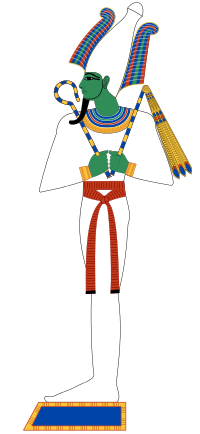 |
day 1 = birthday of Osiris Osiris - god of the afterlife, the underworld and the dead. Brother and husband of Isis, with Horus being considered his posthumously begotten son. Osiris was considered not only a merciful judge of the dead in the afterlife, but also the underworld agency that granted all life, including sprouting vegetation and the fertile flooding of the Nile River. The Kings of Egypt were associated with Osiris in death — as Osiris rose from the dead they would, in union with him, inherit eternal life through a process of imitative magic. Through the hope of new life after death, Osiris began to be associated with the cycles observed in nature, in particular vegetation and the annual flooding of the Nile, through his links with Orion and Sirius at the start of the new year. The Nile, supplying water, and Osiris (strongly connected to the vegetation) who died only to be resurrected, represented continuity and stability. Because of his death and resurrection, Osiris was associated with the flooding and retreating of the Nile and thus with the crops along the Nile valley. |
|||
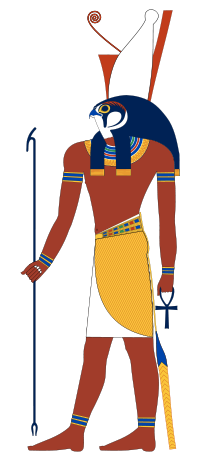 |
day 2 = birthday of Horus Horus - Osiris is the mythological father of the god Horus, whose conception is described in the Osiris myth, a central myth in ancient Egyptian belief. The myth described Osiris as having been killed by his brother Set, who wanted Osiris' throne. Set cut Osiris in pieces and scattered the pieces far and wide. Isis joined the fragmented pieces of Osiris, but the only body part missing was the phallus. Isis fashioned a golden phallus, and briefly brought Osiris back to life by use of a spell that she learned from her father. This spell gave her time to become pregnant by Osiris before he again died. Isis later gave birth to Horus. As such, since Horus was born after Osiris' resurrection, Horus became thought of as a representation of new beginnings and the vanquisher of the evil Set. Pharaoh was the reincarnation of Horus. The documentary movie Religulous (2008), the internet movie Zeitgeist (2007) and the book The Christ Conspiracy claim that Horus was born of a virgin. Egyptian texts demonstrate that Horus’ mother was the goddess Isis, not a human virgin. |
|
||
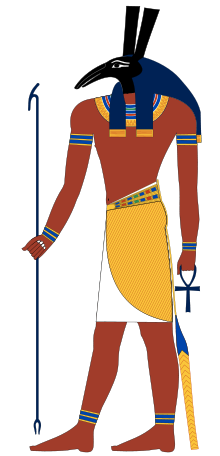 |
day 3 = birthday of Set Set is a god of the desert, storms, disorder, violence and foreigners in ancient Egyptian religion. His siblings are Osiris, Isis, and Nephthys. His wife is Nephthys and in some accounts he had relationships with other goddesses: Hathor, Neith and the foreign goddesses Anat, and Astarte. His homosexual episodes with Horus result in them fathering the moon god Thoth. Set is portrayed as the usurper who killed and mutilated his own brother Osiris. Osiris' wife Isis reassembled Osiris' corpse and resurrected him long enough to conceive his son and heir Horus. Horus sought revenge upon Set, and the myths describe their conflicts. The death of Osiris and the battle between Horus and Set is a popular theme in Egyptian mythology. |
|||
 |
day 4 = birthday of Isis Isis - It was believed that the Nile River flooded every year because of the tears of sorrow which Isis wept for Osiris. Osiris's death and rebirth was relived each year through rituals. The worship of Isis eventually spread throughout the Greco-Roman world, continuing until the suppression of paganism in the Christian era. The popular motif of Isis suckling her son Horus, however, lived on in a Christianized context as the popular image of Mary suckling the infant son Jesus from the fifth century onward. [Wikipedia] Set cut Osiris in pieces and scattered the pieces far and wide. Isis joined the fragmented pieces of Osiris, but the only body part missing was the phallus. Isis fashioned a golden phallus, and briefly brought Osiris back to life by use of a spell that she learned from her father. This spell gave her time to become pregnant by Osiris before he again died. Isis later gave birth to Horus. |
|||
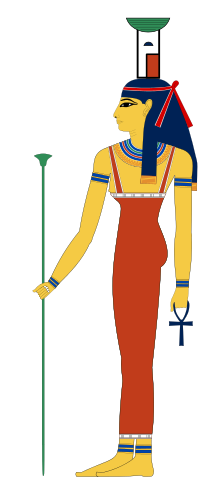 |
day 5 = birthday of Nephthys Nephthys plays an important role in the Osirian myth-cycle. It is Nephthys who assists Isis in gathering and mourning the dismembered portions of the body of Osiris, after his murder by the envious Set. Nephthys also serves as the nursemaid and watchful guardian of the infant Horus (Protective Nurse goddess of Pharaoh). The Pyramid Texts refer to Isis as the "birth-mother" and to Nephthys as the "nursing-mother" of Horus .. she appears to have occupied an honorary position at the holy city of Abydos. Nephthys's healing skills and status as direct counterpart of Isis, steeped, as her sister in "words of power," are evidenced by the abundance of faience amulets carved in her likeness, and by her presence in a variety of magical papyri that sought to summon her famously altruistic qualities to the aid of mortals. Nephthys was also considered a festive deity whose rites could mandate the liberal consumption of beer. |
|||
|
obelisk=phallus of Osiris - The Washington Monument in DC is an obelisk. Wherever you see an obelisk, you are looking at a representation of the Egyptian god Osiris’s lost phallus. The legend, in brief, goes, that Osiris was attacked by his enemy Set and was hacked into 13 pieces, which were then scattered throughout the world [as Osiris was immortal, this was a means of preventing him from seeking revenge]. Isis set out on a quest to find the pieces and recombine him, but she only found 12 of the pieces. The remaining piece, forever lost, was his hacked off phallus, hence she fashioned him a replacement out of gold. This is the obelisk. At the dedication ceremony
of the Washington monument, officiated by prominent Masons, the
keynote speech went: |
||||
|
Birthday of Ra New Years Day Sept 11 |
The Egyptian lunar calendar began with the heliacal rising of Sirius. |
|||
|
The heliacal rising of a star occurs when it first becomes visible above the eastern horizon for a brief moment just before sunrise, after a period of time when it had not been visible. The Egyptian lunar calendar began with the heliacal rising of Sirius (Sothis), brightest star of the night sky. This occurred just before the annual flooding of the Nile and the summer solstice, after a 70-day absence from the skies. The hieroglyph for Sothis features a star and a triangle. Sothis was identified with the great goddess Isis, who formed a part of a triad with her husband Osiris and their son Horus, while the 70-day period symbolized the passing of Isis and Osiris through the duat (Egyptian underworld). |
|
|||
| Inundation (Axt) | Season of Flood - Season When the Nile floods covered the land of Egypt. | |||
| MONTH w/ Plague | ABOUT THE MONTH | SOME RELEVANT EVENTS | ||
|
1=Tekh/Thoth the 1st day of the month of Thout, the first month of the Egyptian year, which for 1901 to 2098 inclusive in the Gregorian Calendar generally coincides with 11 September per the Coptic Calendar. Sept 11-Oct 10
1st Plague; |
The name of the month comes from Thoth, the Ancient Egyptian god of Wisdom. Thoth was considered one of the most important deities of the Egyptian pantheon. he was often depicted as a man with the head of an ibis. Thoth is almost always shown holding a Was (a wand or rod symbolizing power) in one hand and an Ankh (the key of the Nile symbolizing life) in the other hand. Thoth was prominent in the Osiris myth, being of great aid to Isis. After Isis gathered together the pieces of Osiris' dismembered body, he gave her the magic words to resurrect him so she could be impregnated and bring forth Horus. When Horus was slain, Thoth gave the magic to resurrect him as well. |
Opening of the Year Festival of Osiris, Festival of the Departure of Osiris at Abydos (The Neshmet bark was a boat belonging to the god Nun in which the ancient Egyptian god Osiris was transported on the river Nile during the Osiris festival) Festival of Djehuty (Thoth), Festival of Intoxication (for Hathor) |
||
| 2 = Menkhet Oct 11-Nov 10
2nd Plague; |
Menkhet a/k/a The month of Paopi - Heqet = Frog Goddess - To the Egyptians, the frog was a symbol of life and fertility, since millions of them were born after the annual inundation of the Nile, which brought fertility to the otherwise barren lands. Heqet was usually depicted as a frog, or a woman with a frog's head, or more rarely as a frog on the end of a phallus to explicitly indicate her association with fertility. In the myth of Osiris, it was said that it was Heqet who breathed life into the new body of Horus at birth, as she was the goddess of the last moments of birth. As the birth of Horus became more intimately associated with the resur-rection of Osiris, so Heqet's role became one more closely associated with resur-rection. Eventually, this association led to her amulets gaining the phrase I am the resurrection, and consequently the amulets were used by early Christians. |
|
||
| 3 = Hathor Nov 11-Dec 10
3rd Plague;
4th Plague; |
Hathor - The name of the month comes from Hathor, the Ancient Egyptian Goddess of Beauty and Love. Hathor ("mansion of Horus") is an Ancient Egyptian goddess who personified the principles of joy, feminine love, and motherhood. She was one of the most important and popular deities throughout the history of Ancient Egypt. Hathor is commonly depicted as a cow goddess with head horns in which is set a sun disk. She is depicted as "Mistress of the West" welcoming the dead into the next life. |
Festival of Hathor At Dendera, the place of her sacred and most famous temple, rituals and celebrations commenced before dawn with the placement of a ritual mirror in the temple's doorway. This was done so that the first rays of the rising sun would be reflected back into the temple. Mirrors were considered to be sacred to Hathor, who was, after all, the Egyptian goddess of Beauty. Egyptian mirrors were made from metal polished to a high sheen. Often they were shaped with the body or head of Hathor that formed the handle. This way the user of the mirror would never forgot to honor the goddess. |
||
|
4=Ka-hr-ka Dec 11-Jan 8
5th Plague; |
The name of the month of Koiak comes from *Ku har Ku 'Soul upon Soul', a name of the Ancient Egyptian sacred Apis Bull. Apis or Hapis is a bull-deity. "Apis served as an intermediary between humans and an all-powerful god (Osiris)." [quote: Virtual Egyptian Museum] This animal symbolized the king’s courageous heart, great strength, virility, and fighting spirit. The Apis bull was considered to be a manifestation of the pharaoh, as bulls were symbols of strength and fertility, qualities which are closely linked with kingship. Occasionally, the Apis bull was pictured with the sun-disk between his horns
|
Feast of Apis/Hapis/Hapi The Apis bull was also known as the Hapis Bull or "Hapi-ankh". The bull was the incarnation of a god, but unlike the other animal totems (who only provided a link to the god) the Apis was thought to host the god himself. ..Plutarch described the Apis as the "fair and beautiful image of the soul of Osiris". An [actual] sacred bull was identified by specific sacred markings. [There could be only one recognized Apis bull at a time]. Once the bull had been confirmed as the incarnation of a god, it was housed in plush quarters, given only the best food, and provided with a harem of the best cows. The lucky animal would live in the lap of luxury until its death when it would be mummified and buried with full honours [and the search for another Apis bull would commence.] The Festival of the Apis Bull lasted for seven days. The sacred bull was led through the streets as the people cheered.
Day 18 start of the Khoiak
ceremonies:
Djed-pillar - The idea of
completing the circle with ritual and of finding balance in awareness
was known in ancient Egypt as raising the Djed. The purpose of the
ritual was to preserve order and repel chaos. In order to do this there
first had to be an effort to raise this "awareness’" or "Djed."
Those
that did this were known as "Djedi." The main tenet of the Star Wars
universe is completion of the circle or finding the balance between good
and evil. |
||
| Emergence (Peret) |
Season of Sowing - Peret was the season where the annual Nile flood retreated leaving a rich and fertile layer of black silt, making it ideal for planting crops. |
|||
| 5=Sf-bdt/Ta'b Jan 9-Feb 7
6th Plague; Boils |
Shefbedet = Ta-aabet = Coptic Tobi (approximately December, ideally)The name of the month of Tobi comes from Amso Khem, a form of the Ancient Egyptian god Amun Ra, the ancient Egyptian solar deity, major god in ancient Egyptian religion, identified primarily with the midday sun. The major cult centre of Ra was Heliopolis. All forms of life were believed to have been created by Ra, who called each of them into existence by speaking their secret names. Alternatively humans were created from Ra's tears and sweat, hence the Egyptians call themselves the "Cattle of Ra." |
Festival of Nehebkau
|
||
| 6 = Mechir Feb 8-March 9
7th Plague;
8th Plague; |
Meshir a/k/a Amshir - second month of the Season of 'Proyet' in ancient Egypt. Amshir is the month of howling winds and sandstorms, which is why it is named after Mechir, the Ancient Egyptian god of wind. |
'Amun-in-the-festival-of-raising-heaven', (Relates to sky and weather) this is the halfway point of the year, ideal 'midwinter' |
||
| 7 = Pa-en-Amenhotep Mar 10-Apr 8
9th Plague;
10th Plague; Death of Firstborn
|
The Coptic name Paremhat comes from the Egyptian name of the month, pa-en-Amenhotep, "month of Amenhotep", (Amenhotep, sometimes read as Amenophis and meaning "Amun is satisfied") who was deified in the polytheistic Ancient Egyptian religion following his reign (ca. 1500 BC) – the month formerly known as Rekeh-nedjes being renamed in his honor.
Amun - Amun was a primordial Egyptian god, whose name means "the
hidden one" or, in other words,
the "dark one". As the driving force of
the invisible breeze he was originally a god of wind and ruler of the
air. He was called the 'King of the gods'. Amun was important throughout
the history of ancient Egypt. However,
when Amun was combined with the
sun god Ra he was even more powerful. He was then called Amun-Ra.
|
The festival 'Amun-in-the-festival-of-raising-heaven'
continues including day of return of the image of the deity.
Amun -
Amun represented as a
Man with a ram-head. A sistrum which mentions
Ptolemy II carries the
text: "the august sistrum gives praise to the Lord of heaven, the
Foremost of the temple: Amun, the Ram of Mendes" (Van Siclen, 1985, p.
228-229)Mendes is the Greek name for the Egyptian nile delta city of
Djedet [city of the Djedi]. Banebdjedet, Whose name means “the Ba-Soul/Ram
Lord of Djedet” is identified with the Ba (the soul) of Osiris, and with
the four Bau (the souls) of Ra. |
||
| Israel was set free after 10th Plague, in the 7th Egyptian month, in the first Hebrew Month | ||||
| Copyright 2013 Tsiyon.org | ||||
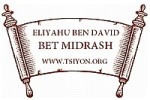







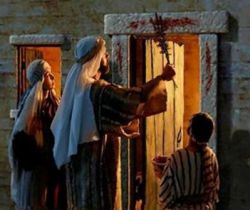

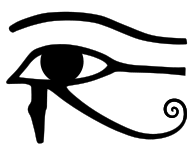
 Sirius is often called the "Dog Star" as the brightest star of Canis
Major, the "Great Dog" constellation. It was depicted as Orion's
dog.
Sirius is often called the "Dog Star" as the brightest star of Canis
Major, the "Great Dog" constellation. It was depicted as Orion's
dog.
